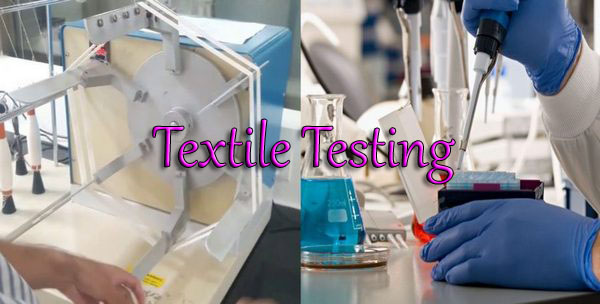What is Textile Testing?
The process to determine the properties of different kinds of substance is called testing. Testing is an important segment of the textile industry. We can easily detect the faults of machinery and materials during test of textiles. Besides, textile testing needs to assure compliance with changing governmental safety regulations and to meet increasing consumer demand for high-quality textiles and apparel.

Testing of textiles refers to numerous procedures for assessing myriad fiber, yarn and fabric characteristics such as fiber strength and fineness, yarn count and twist and fabric weight, thickness, strength, abrasion resistance, color fastness, wrinkle resistance and stiffness. It is the application of engineering knowledge and science to the measurement of the properties and characteristics of, and the conditions affecting, textile materials. It involves the use of techniques, tools, instruments and machines in the laboratory for the evaluation of the properties of the textiles. Textile testing has become more important in recent years as a result of the new demands placed upon the products of textile manufacturers.
Types of Textile Testing:
- Routine process testing
- Quality record testing
Objectives / Purposes of Textile Testing:
- For researchers, testing results aid the development of new products or new processes, which can save money and resources before production starts on an industrial scale. They also help in the choosing of the best possible route to achieve the end product.
- Testing helps in the selection of the best possible raw materials. “Raw material” is a relative term; for example, fiber is the raw material for spinning, and yarn is the raw material for weaving.
- Testing helps in the process control through the use of advanced textile process-control techniques.
- Testing ensures the right product is shipped to the consumer or customer and that the product meets the customer specifications.
Testing in general, and textile testing in particular, is affected by the following factors: Atmospheric conditions affect test results as textile products are greatly influenced by moisture and humidity. The test method adopted will also cause variation in test results. The testing instrument is also a vital part and, if not properly calibrated, can cause serious variation. Human error is another source of variation.
Textile testing starts with textile fibers and goes all the way through to the final product. The fiber test includes the length, strength, elongation, fineness, and maturity. The yarn test includes linear density, single yarn strength, yarn evenness, and yarn hairiness. The fabric test includes aerial density, weave type, and air permeability.
Factors Affecting Test Result:
- Atmospheric conditions during test.
- Method of test.
- Testing instruments used.
- The efficiency of technicians etc.
Different Types of Textile Testing Methods:
Fiber test:
- Identification of fiber
- Grading
- Fiber length
- Strength and elongation; tensile properties
- Fineness or linear density test
- Maturity test
- Trash, neps test etc.
Yarn test:
- Yarn count or linear density
- Twist per unit length
- Strength and elongation i.e. tensile properties
- Appearance
- Evenness and regularity
- Hairiness
Fabric test:
- Strength and elongation test i.e. tensile properties
- Width
- Thickness
- Number of ends and picks per unit length
- The count of yarn used
- Fabric weight per unit length
- Design and construction of the cloth
- Air permeability
- Thermal properties
- Stiffness, handle, drape
- Crease resistance and recovery
- Abrasion
- Pilling tester machine
- Shrinkage
- Water absorbency or resistance etc.
Importance of Textile Testing:
The main reasons for textile testing are control of product, control of raw materials, process control and analytical information. Testing is actually a two-way process, in which the incoming raw materials that will be needed to manufacture the company’s products will be scrutinized to ensure that they meet the specifications. That is, any manufacturing problems will be minimized while also ensuring that the textile item thus made will not result in problems for the customers; namely, that the item being manufactured is a quality product. A key issue in modern testing is to understand the complexity of the instruments and their working principles and finally to interpret the results in a systematic and scientific way.
Testing is important, mainly for customer satisfaction of the textile product as well as to ensure product quality for the market in which the textile manufacturer competes. Testing is also important in order to control the manufacturing process and cost. In the textile industry, it is very important to use testing to control the manufacturing process for cost and other reasons. The importance of testing cannot be disregarded for product satisfaction and control of manufacturing cost. There are additional reasons such as customer relations, reputation, employee satisfaction and sales. Proper testing programmes are a very important ingredient of the efficient manufacturing business. Testing informs us whether the product will be saleable or not. How to test textile.
